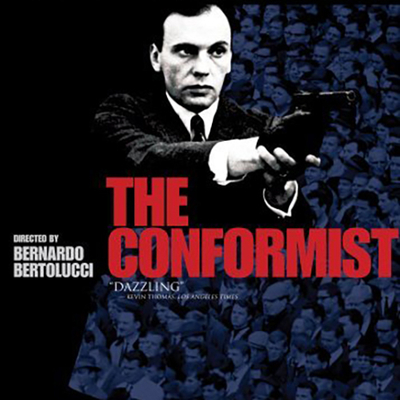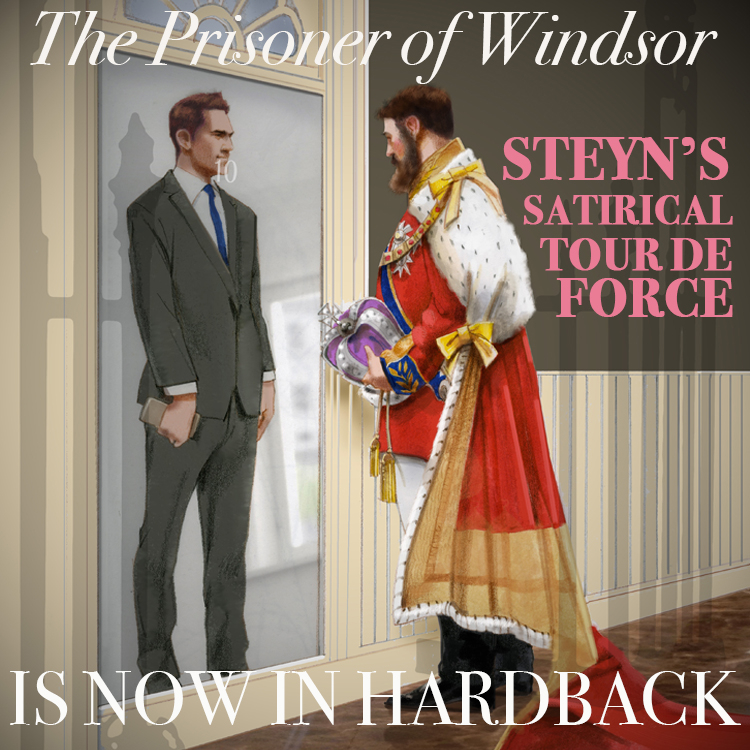The word fascist gets thrown around a lot now, almost inevitably without context or understanding, and mostly as a shorthand to tar an object of hatred and signal that the utterer is certain that the world is heading for a dark place, from which only their worldview offers salvation. It would seem like a good time to stop and try to understand one of the only political movements to explicitly call itself fascist and remind ourselves what it really means.
But we may be too far down the road for anything that looks so much like sober reflection.
We might actually have been too far down that road in 1970, when director Bernardo Bertolucci released The Conformist (Il Conformista), a film about a man who joins Benito Mussolini's Fascist party at the zenith of their power. To say that Berrtolucci's film was successful is an understatement; it was a critical hit and a major influence on the Godfather films that were made not long afterward, but it also set the tone for how period films, the authoritarian '30s, and right-wing politics would be shown onscreen for decades.
Bertolucci's film is part of a peculiar moment in movie history where, just when the effects of the social revolution of the '60s were remaking society and its generational shock troops were taking their place as adults and not youth, movies became fascinated with the world that preceded them – roughly the late '20s to the early '50s. Like so much else that begins with Arthur Penn's Bonnie and Clyde in 1967, nudged forward firmly by They Shoot Horses, Don't They? (1969) and The Conformist.
What followed was a fascinating mixed bag of period pictures, from Summer of '42 in 1971, Cabaret and The Godfather in 1972, Dillinger, The Sting, Paper Moon and Emperor of the North Pole in 1973, Chinatown, The Great Gatsby and The Godfather II in 1974 to the peak in 1975 with The Day of the Locust, Hearts of the West, Hard Times, Farewell My Lovely, Capone, The Great Waldo Pepper, The Hindenburg, Funny Lady, Inserts, At Long Last Love, The Wild Party and Doc Savage: the Man of Bronze.
The moment petered out after that with Hal Ashby's Bound for Glory in 1976. By the time Martin Scorsese followed up Taxi Driver with New York, New York in 1977, the period would become more stylized, its treatment more self-conscious, as if a critical mass of people with adult memories of the period had left the ranks of talent making these pictures.
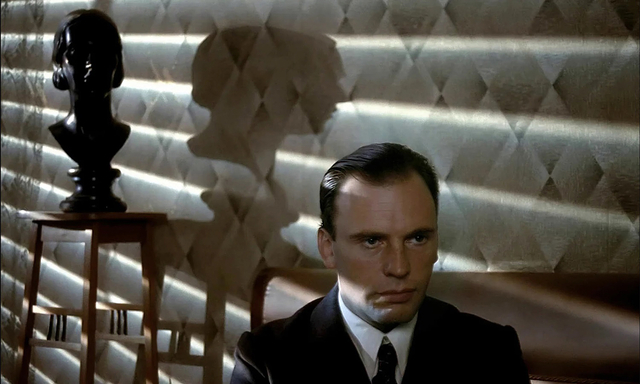
The opening of the film plants us firmly in the period, with Marcello Clerici (Jean-Louis Trintignant) sitting in a hotel bed while the light from a neon sign outside blinks on and off, casting the frame deep red, like colour invading a film noir. The titles playing over him are set in an Art Deco font, and Georges Delerue's music is suitably evocative of the period which, we come to learn, is 1938, with the world on the verge of war.
The phone rings and Marcello agrees to meet someone outside; a naked woman lies face down on the bed. He puts on his coat, hat and gloves and gets in a car driven by Manganiello (Gastone Moschin, who would play Don Fanucci in The Godfather, Part II), who tells him that the woman has joined the man they are following, an unexpected turn of events, apparently, though not one that will alter their plans.
The first flashback of the picture takes us back several months, to Marcello on the other side of a glass window looking into the brilliant Deco elegance of a radio station studio where a singing trio – an Italian Andrews Sisters – are performing "Chi È Più Felice Di Me?" ("Who is Happier than Me?"). Marcello is telling his friend Italo (Jose Quaglio) that he's going to get married; Italo is blind, an ideologue working for the fascist government, delivering radio monologues praising the "Prussian aspect" of Mussolini and the "Latin aspect" of Hitler to provide domestic audiences with some intellectual legitimacy to the never very equal Pact of Steel.
In the beginning the senior partner in the relationship was Mussolini, whose March on Rome in 1922 had made him Italy's political leader, a year before the copycat Beer Hall Putsch in Munich got Hitler and other senior National Socialists imprisoned. Mussolini would fund Hitler and his party during their decade in the political wilderness, but when they became peers at the helm of their countries, il Duce admitted in private that he found der Fuhrer's rambling monologues on Aryan racial theory tedious and ridiculous. In speeches he noted that Germany was peopled with hut-dwelling barbarians when Rome was a gleaming empire of marble.
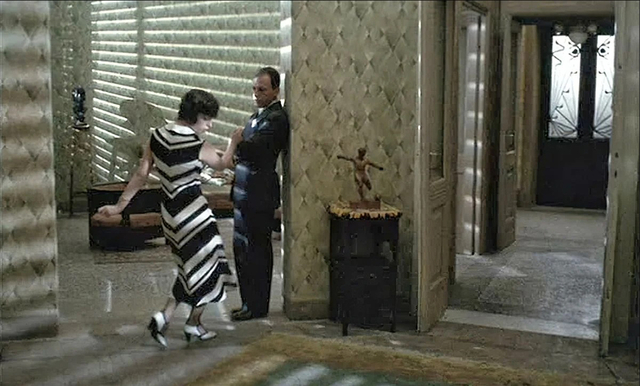
Marcello's fiancée is Giulia (Stefania Sandrelli); she was the woman on the bed in the hotel room, though we're properly introduced for the first time in her parents' flat, a showcase of vernacular Art Deco into which she harmonizes perfectly, the shadows through the window blinds making dazzling patterns across the wallpaper and her striped dress.
She's a lovely idiot whose background Marcello sums up to Italo as "petit bourgeois". Forced to make a confession before they can get married in the Church, he describes her to the priest as "all bed and kitchen." Marcello craves normalcy and the opportunity to disappear into the crowd and since the Italian crowd has declared its allegiance to Mussolini, he's seeking the veneer of domesticity and a position in the OVRA, the secret police, with Italo's help.
In the confession booth he tells the priest that he has committed every sin, including murder; he recalls his sexual molestation as a boy by Lino (Pierre Clementi), a chauffeur who tempts him with the gift of a Mauser pistol, which the young Marcello turns on him. Marcello is surprised that the priest is more interested in potential sodomy and the details of Marcello's more typically middle-class sex life – a visit to a brothel with his father at 18, the usual promiscuous opportunities afterward – than in the murder.
He admits to the priest that he's more interested in absolution from society than the Church, less for the murder he committed in the past than the ones he is likely to commit in the future, as an agent of that society. He hints that he will be joining the secret police and is taken aback when the priest suddenly gives him absolution.
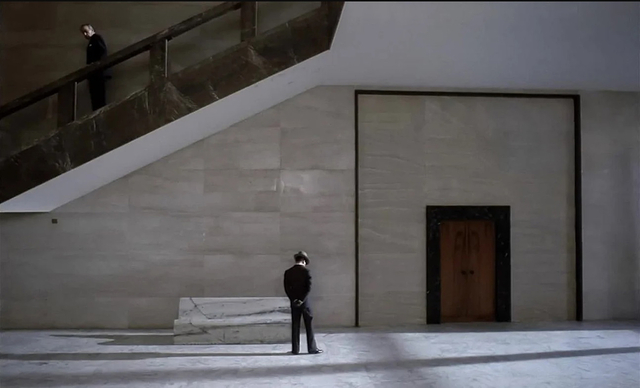
Marcello allows himself to be processed through the corridors of power in the fascist government – long hallways and vast, sterile, epic spaces filmed in the EUR, the Esposizione Universale Roma, a planned subdivision intended to host the 1942 World's Fair that was canceled by the outbreak of a war that Mussolini told Hitler Italy was still unprepared for when Germany invaded Poland in 1939. Michelangelo Antonioni would film L'Eclisse in the EUR in 1962, using it to depict modern anomie instead of fascist brute order.
Marcello is assigned to renew an acquaintance with Quadri (Enzo Tarascio), his old university professor, now an anti-fascist exile living in Paris with his wife Anna (Dominique Sanda). He decides to combine the assignment with his honeymoon, and is given the services of Manganiello, a veteran of Mussolini's state security agency. His name literally translates as "truncheon" or cudgel, a tool of coercion usually accompanied with castor oil by black shirt thugs.
Manganiello shadows Marcello when he visits his recluse mother at her decrepit mansion, where her Japanese chauffeur Ki is supplying her with morphine. He's happy to use the thug to strongarm the driver out of his mother's life before they visit his father in a lunatic asylum where the inmates roam between the benches in a vast white stone amphitheatre – the roof of Adalberto Libera's Palazzo dei Congressi in the EUR.
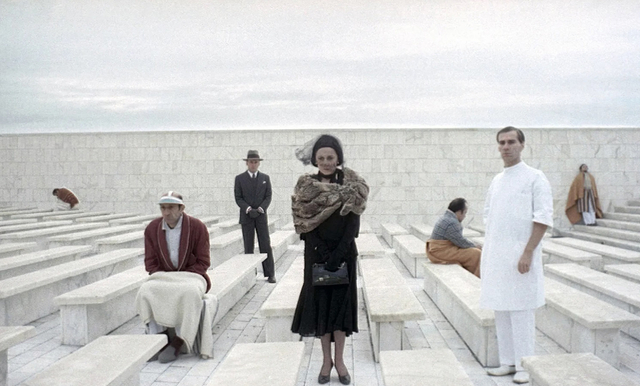
The old man is obsessed with "massacre and melancholy", writing the words over and over on loose sheets of paper. He's convinced himself that he is one of Mussolini's closest advisors and his son taunts him by accusing his father of using the cudgel and castor oil on victims of the state.
Probably the greatest influence of The Conformist was visual: thanks to cinematographer Vittorio Storaro (Last Tango in Paris, Apocalypse Now, Reds, One from the Heart, The Last Emperor) it has a cool formal elegance and delivers frame after ravishing frame that does a lot to help Bertolucci's deceptively simple story land. In the short term it inspired Gordon Willis' rich, dark camera work on The Godfather, and did a lot to banish the old, flat, overlit TV-influenced color cinematography that dominated widescreen Hollywood pictures since the studio era.
On the way to Paris Marcello and Giulia stop in Ventimiglia where he gets further instructions at a brothel that's a front for the local fascist headquarters. He finds Manganiello waiting for him, entertaining a prostitute played by Sanda in an outrageous red wig. Sanda also appears briefly as the mistress of the fascist minister in Rome who gives Marcello his assignment; it's one of many surreal touches in the film, like the piles of walnuts all over the office of Raoul, the head fascist in Ventimiglia, who informs Marcello that his mission has changed: instead of obtaining information on Quadri, he has to kill him.
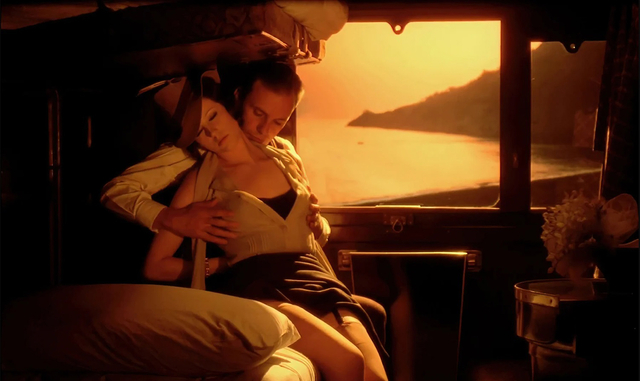
Back in the train Giulia, playing the tragic heroine in a melodrama she fondly imagines, informs Marcello that she had been molested as a teenager by a friend of her family – a lawyer who was one of the witnesses at their wedding. (He was also, she blithely admits, the anonymous author of a letter to her mother accusing Marcello of suffering from the same syphilis that had driven his father mad.)
But Marcello has no feeling for conventional morality, and instead of being outraged or disappointed he finds his wife's confession arousing, perhaps because it echoes his own molestation as a boy. Like many other pictures made during this period – Luchino Visconti's The Damned (1969) and Liliana Cavani's The Night Porter (1974) – The Conformist makes an explicit connection between sexual perversion and fascism that was very voguish at the time.
In Paris Quadri is happy to meet with his old student despite being certain that he's a fascist agent. For his part Marcello falls in love with Anna who, in her turn, is attracted to Giulia. The two couples are drawn into each other's orbits for reasons that are alternately mercenary, sexual or sinister. That this will not end well is underscored by Manganiello, who shadows them constantly in spite of Marcello's efforts to evade him.
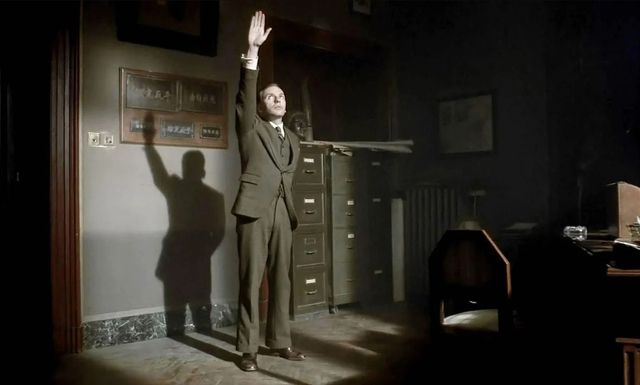
Bertolucci's movie was based on a novel by Alberto Moravia, published in 1951 and an early source of the mooted connection between sexual repression and fascism. But the director – with Moravia's tacit permission – omitted key passages from the book that explained the roots of Marcello's amorality and longing to submerge himself in the "normality" of an authoritarian political state.
Marcello's cruelty to animals as a child is only hinted at in the movie, even less the violent abuse of his mother by his father. His molestation by Lino is explored more in the book, while Bertolucci created the character of Italo and wrote a whole new scene – a party full of blind people in a basement, a celebration of Marcello's engagement where he's visibly repelled by his friend's certainty that they're both desperate to appear normal because they're at heart both unable and unwilling to meet mainstream expectations.
It's a strange scene that's meant to be comic but carries too much of the metaphor Bertolucci was keen to use to explain both Marcello as a man and Italy's fervent love affair with fascism – and its abrupt rejection of Mussolini when the war turned against them. It's not surprising that it was cut from the original U.S. release of the picture and only restored for the 2006 DVD reissue.
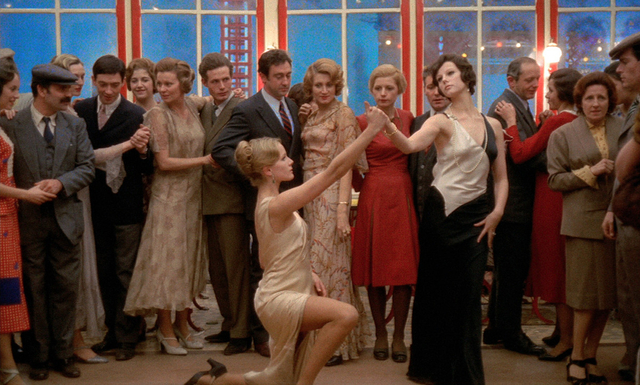
There's a scene in Quadri's office where the teacher and his pupil are reunited and Marcello recalls his lecture about Plato's Cave – a little pretentious, perhaps, but beautifully choreographed and lit by Bertolucci and Storaro. But there are two abiding set-pieces in the film, the first of which is a dance hall where the two couples go on the night before the scene that opens the film.
Quadri has tested Marcello's loyalty by asking him to carry a letter to a friend in Italy, which he reveals to be blank later. A smart man, the professore isn't as clever as he thinks he is, and concludes that this test proves that Marcello isn't a real fascist. In the meantime Anna openly flirts with Giulia and leads her on to the dance floor for a tango, providing the image that has proved to be the salient one in the picture.
(Bertolucci famously assigned the Quadris the Paris address of his hero and mentor, Jean-Luc Godard, who was apparently disappointed by the picture. He claims he did it as a joke but realized later that it was a kind of betrayal: the acolyte embracing the conventions and visual style of cinema's past and rejecting the permanent revolution of his teacher.)
Giulia impulsively leads everyone in the hall in a dance, a chain of people holding hands who circle the building and return to surround Marcello, trapped in the centre of an ever-tightening mob – the fulfilment of his dream, in theory, though it looks more like a human prison. He has been a mobile character throughout the picture, moving with a swift, stiff-legged walk, careful to avoid too much contact, and this is how we see him on the last night before the day that will define his life.
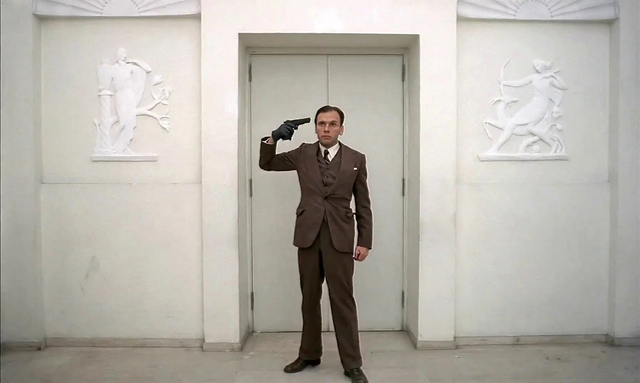
Just as Storaro's camerawork looks stylized, Trintignant goes out of his way to portray Marcello as abidingly strange, impulsive and even childlike in spite of his efforts to appear unremarkable. He keeps a blank expression on his face while his body exudes rogue energy; one moment he moves like an automaton through the halls of the fascist ministry in Rome, but when given a gun to kill Quadri by Raoul, he wheels about the room with the weapon before pointing it at his own head.
He's too smart to fall for fascist tropes about the creation of a "new man" suitable to the new world men like Mussolini want to create, but he lacks the brute misanthropy of Manganiello, a man capable of anything who mutters to himself with disgust when Marcello's nerve fails at the last minute. "Cowards, homosexuals and Jews," the thug grumbles while he urinates in the woods. "If it were up to me I'd stand them all up against the wall. Better yet, eliminate them when they're born."
At the film's climax the Quadris are ambushed driving through the forest to their country place in Savoy. The professor is set upon by men in long coats and hats who dart in with their knives like Brutus and the other assassins killing Caesar on the Senate floor. Anna tries to escape, pleading hysterically with an impassive Marcello as he sits hunched inside Manganiello's car. When the screaming and gunshots stop the scene returns to the sound of the trees shifting and cracking in the cold. (The Sopranos would pay tribute to this scene in "Pine Barrens", the famous season three episode directed by actor Steve Buscemi.)
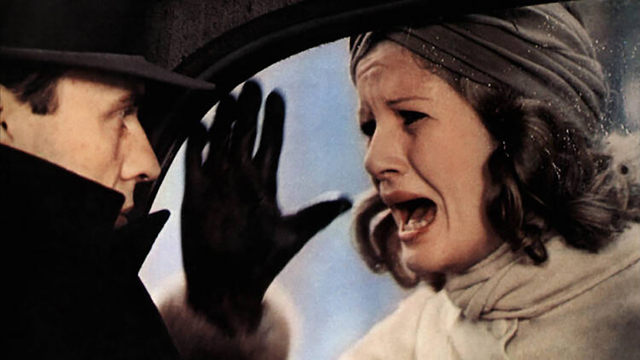
Bertolucci inserts a coda into the film – an ending that departs considerably from the one in Moravia's book, where Marcello goes out to meet Italo on the night in 1943 when King Victor Emmanuel dismissed Mussolini and began peace negotiations with the Allies. Reading the energy of the mob and its need for revenge he encounters Lino, still alive, propositioning a homeless young man, a hustler living in the ruins of the Theatre of Marcellus.
He denounces Lino as a homosexual and accuses him of the murder of the Quadris, then turns on Italo, who he abandons to be swept away by a marching crowd celebrating Mussolini's downfall. If it's supposed to provide some insight into the mind of a man who embraced fascism without either enthusiasm or conviction, it's adequate but hardly insightful.
Fascism, we're told by The Conformist, thrives in a decadent society where the declining upper class joins with the striving petit bourgeoisie to coerce the working class (faceless except for Manganiello and the refugees Marcello and his wife are forced to take into their apartment while Italy is losing the war) into enforcing their new social order and dying in their wars of conquest. This would have been plausible to a Marxist like Bertolucci, and for years it has been a sufficient formula to describe fascism and denounce every enemy of anyone who flatters their worldview by calling it "anti-fascist."
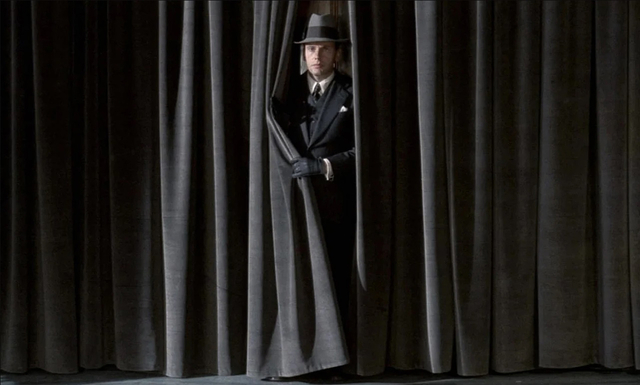
There's no denying that Storaro and Bertolucci's masterful visuals do a lot to sell this simple idea. But writing about the film in his book Italian Cinema from Neorealism to the Present, Peter Bondanella concludes that "as a coherent explanation of the birth of a Fascist, The Conformist fails just as certainly as did the theories of Wilhelm Reich in The Mass Psychology of Fascism (1933) or of Erich Fromm in Escape from Freedom (1941), works which obviously influenced Bertolucci's adaptation of Moravia's novel."
Bertolucci's insistence on the middle-class origins of fascism isn't even coherent according to Bondanella, since "the only milieu ever reflected in The Conformist, that of the decadent bourgeoisie, includes not only Marcello and his family but also the anti-Fascist Quadri couple as well." They are members of the same decadent class and "far from an explanation of Fascism, The Conformist is, in reality, only an indictment of it, and the verdict has already been delivered before the film is made."
But these thoughts, as well as the unworthiness of the protagonist, are swept aside by performances like Trintignant's and what Bondanella calls "the film's strikingly brilliant visual texture," where "careful composition of individual shots, as well as intricate attention to the effects of light and shadow, emphasize the film's dominant motifs of Marcello's entrapment and the metaphor of blindness."
In this light it's hard not to consider The Conformist as the kind of propaganda that fascists more than anyone else understood as perfectly delivered by movies rather than any poster or slogan or crushingly dull and badly written manifesto. Something to think about as the world becomes more relentlessly visual and undeniably post-literate than we could have imagined in 1938 or 1970.
Club members can let Rick know what they think by logging in and sharing in the comments below, as access to the comments section is one of many benefits that comes along with membership in the Mark Steyn Club.


